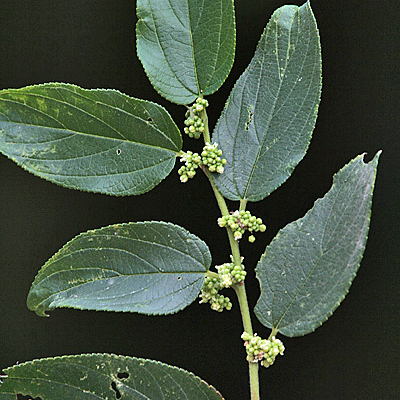Trees or shrubs, evergreen, monoecious, with simple hairs and sometimes with multicellular glandular hairs. Leaves alternate, penninerved; stipules free, extrapetiolar, caducous. Inflorescence an axillary panicle or thyrse, either unisexual or with both male and female flowers; bracts minute, caducous. Male flower globular; perianth 4-or 5-lobed, induplicate-valvate; stamens 4 or 5, included or exserted; anthers dorsifixed, introrse; pistillode present, hirsute. Female flowers ovoid; perianth 4-or 5-lobed; staminodes usually present; ovary sessile, with short style; stigmas spreading or incurved. Fruit a drupe. Seeds with or without endosperm; embryo curved.
Bisexual or monoecious trees or tall shrubs. Leaves alternate, distichous, more or less inequilateral, mostly serrate, shortly petiolate; stipules lateral. Inflorescences solitary, cymose or fasciculate. Bisexual flowers: sepals 4-5, connate at the base; stamens as many as and opposite the calyx lobes, anther dehiscence introrse; ovary sessile, 1-locular, the styles connate below. Staminate flowers with rudimentary pistil. Pistillate flowers without staminodes. Fruit a small ovoid or subglobose drupe with persistent styles, the embryo curved, the cotyledons falcate, thick.
Trees or shrubs, monoecious or dioecious, unarmed. Leaf-blades penninerved, usually serrate, ± scabrous. Stipules paired, lateral, free. Inflorescences usually congested axillary cymes with ♂ and ♀ or hermaphrodite flowers. Sepals (4–)5, shortly united, with ♂ buds induplicate-valvate and ♀ buds ± imbricate. Stamens equal in number to the sepals. Ovary sessile, 1-locular; styles short, divaricate or inrolled, unbranched, ± persistent. Drupes small, thinly fleshy; endocarp hard.
Trees or shrubs without spines, dioecious or monoecious. Inflorescences bisexual or unisexual. Tepals 5; stamens 5 and opposite the tepals; stigmas unbranched. Fruit up to 3 mm long.
Inflorescences axillary, cymose, often branched, usually congested, mainly male with female and bisexual flowers fewer and borne towards the apex.
Leaves alternate, penninerved, petiolate, unequal-sided at the base, serrate; stipules lateral, paired, free, caducous.
Sepals (4)5, shortly united at the base, induplicate-valvate in male buds, and imbricate in female buds.
Ovary sessile, 1-locular; styles short, unbranched, divaricate or inrolled, persistent.
Trees or shrubs, monoecious or dioecious, unarmed.
Fruits small, endocarp hard.

